Photos by T.R. Van Devender unless otherwise credited
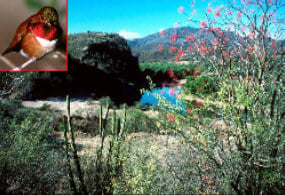
The environmental transect along MEX 16 in eastern Sonora begins in foothills thornscrub at 200 m elevation near Tónichi on the Río Yaqui. A total of six species of hummingbirds were observed along the river. |
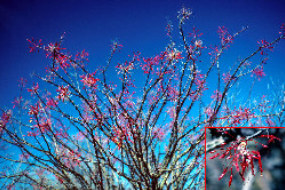
The tree ocotillo or ocotillo macho (Fouquieria macdougalii) is the most important hummingbird food plant in the Plains of Sonora subdivision of The Sonoran Desert in central Sonora and foothills thornscrub to the east. This small tree has abundant red flowers from late February to early April during the northward hummingbird migration. |

The most common lowland hummingbirds are resident Costa’s ( Calypte costae) and broad-billed ( Cynanthus latirostris) hummingbirds. Perched male Costa’s with their iridescent purple ‘moustache’ are especially conspicuous. Photo: J. Flynn at ASDM
|

Anna’s hummingbird (Calypte anna) is one of the few winter-breeding hummingbirds. It has an unusual distribution that was historically centered in California with winter migrants in Arizona. Later it’s range has expanded into Sonora south as far as Guaymas and Puerto Peñasco from September through April. Anna’s hummingbird is often an urban species that appears soon after feeders are provided. In the Yécora area it has been seen in December visiting tree morning glory (Ipomoea arborescens) in tropical deciduous forest and in September on Mesa del Campanero visiting Texas betony (Stachys coccinea). Photo: K. Krebbs at ASDM.
|
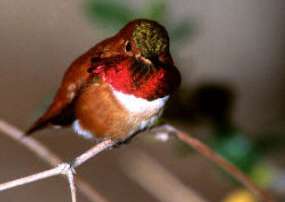
The rufous hummingbird (Selasphorus rufus) has the longest migration of any North American hummingbird, from Alaska to southern Mexico. In the spring, northward migrating individuals pass through the tropical lowlands of Sinaloa into southern Sonora and then along the Río Yaqui to the Tónichi area. Rufous hummingbirds are very aggressive, challenging residents and other migrants for nectar in local patches of flowering plants. Photo: K. Krebbs at ASDM.
114A. Arroyo Los Huérigos is a stream in a tropical deciduous forest canyon at 650 m elevation just east of Tepoca. Huérigo (Populus monticola) is the common name of a cottonwood that is found in southern Baja California and east-central Sonora. It was used as a surrogate for the heat-intolerant quaking aspen (P. tremuloides) in the Mountain Woodland exhibit at ASDM. A total of ten species of hummingbirds were seen in tropical deciduous forest along the Tónichi-Yécora transect. |
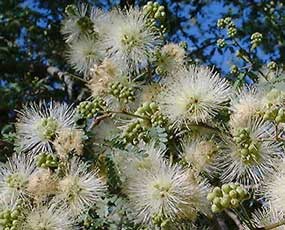
Palo chino (Havardia mexicana) does not have typical hummingbird flowers, but blooming trees are heavily visited and defended by hummingbirds. Photo: Mark Dimmitt |
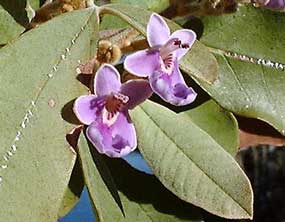
Uvalama (Vitex mollis) flowers fit the bee pollination syndrome, but they too are heavily visited by hummingbirds. Photo: Mark Dimmitt
|
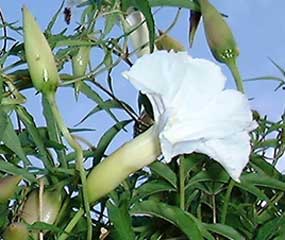
Trompillo blanco (Merremia palmeri) flowers at night and is pollinated mainly by moths. But hummingbirds will visit the flowers early in the morning before they close. Photo: Mark Dimmitt
|
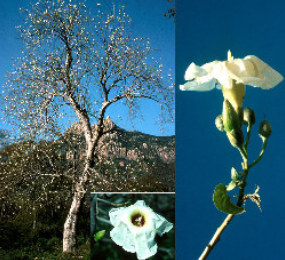
Like many tropical trees, the tree morning glory or palo santo (Ipomoea arborescens) flowers in the dry season when it is leafless. In Sonora the large white flowers bloom from November through March. The flowers are an important resource for northward-migrating hummingbirds in the spring because it is one of the few important nectar plants whose range extends from southern Mexico to Sonora, nearly to the Arizona border. Moreover, it flowers dependably regardless of rainfall. Most other morning glories (Ipomoea spp.) are vines with red, purple, blue, or white flowers during the summer rainy season from July to September. The Spanish common name for all of them is trompillo. Photos: left: S.A. Meyer; right: C.D. Bertelsen; inset: T.R. Van Devender.
|
|
